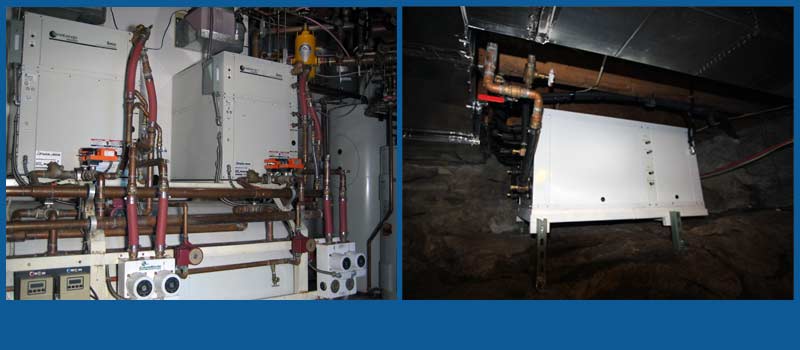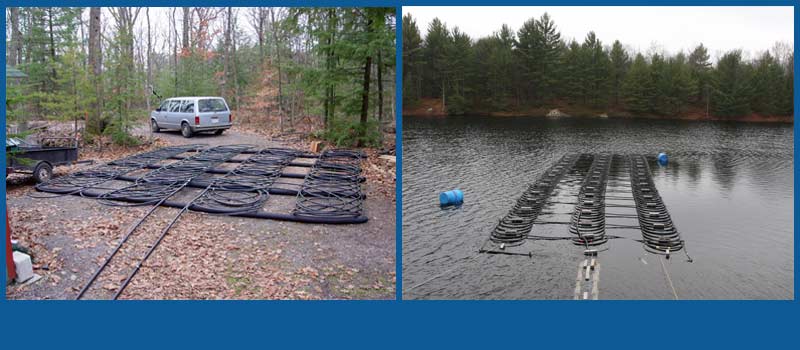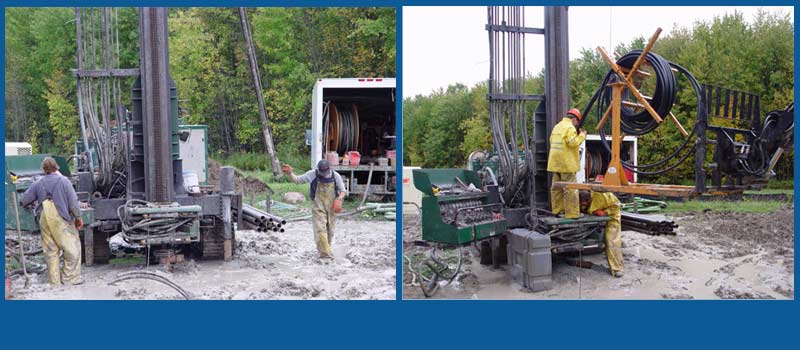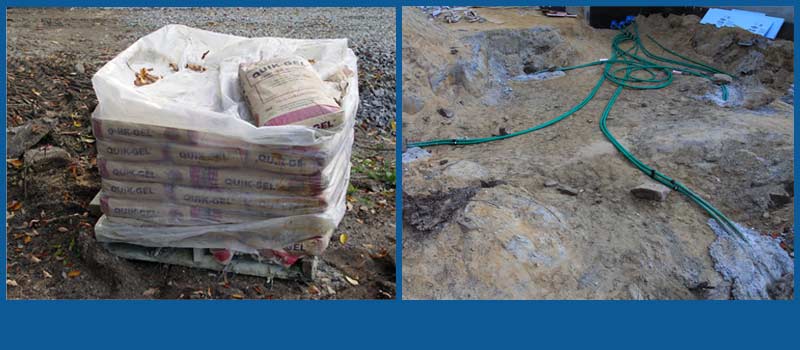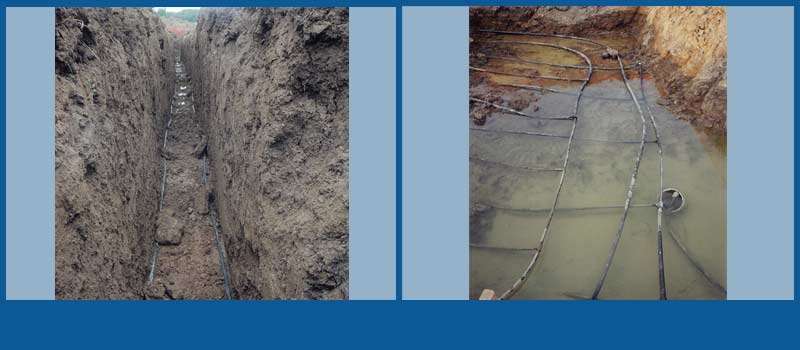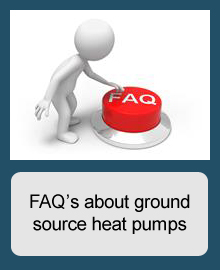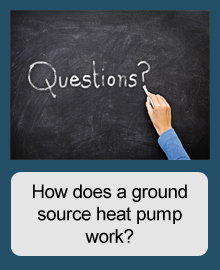
Reducing the environmental and monetary cost of energy |
What are ground source heat pumps
A ground source or geothermal heat pump is a heating and/or cooling system that transfers heat to or from the ground.
There are many good reasons to install a ground source heat pump. To most of our customers the choice comes down to the low operating cost to heat and air condition a building and the environmental benefits.
A heat pump only moves heat around. By operating a ground source heat pump we borrow the ground heat to warm up our building. Over time the heat from our building is lost back to environment where it came from. It takes less energy to move heat around than to create it. That benefits the environment as well as the pocket book.
A ground source heat pump delivers three unbeatable advantages:
- It can provide year- round heating/cooling and domestic hot water.
- A well installed ground source heat pump will provide between three and five times as much heating or cooling output as the energy consumed to operate it.
- The use of a ground source heat pump reduces the carbon footprintCarbon FootprintThe total of greenhouse gas emissions caused by an organization, event, product or person. of a building more than any other single piece of equipment.
Modern ground source heat pumps are more durable and reliable than many other types of heating and cooling equipment. The technology has been around for over a hundred years. Today it is represented in the market by many Canadian and foreign manufactures.
Ground source heat pumps are available in many sizes and configurations to provide forced airForced AirA system that uses air as the heat transfer medium in heating or cooling systems and relies on ducts, vents and plenums as means of air distribution. heating/cooling, hydronicHydronic HeatingA system that uses water as the heat transfer medium in heating or cooling systems and relies on piping as means of water distribution. heating/cooling and domestic hot water. They are similar in size to other heating and cooling equipment. A ground source heat pump can be used to provide all the heating and cooling in any size building, residential or commercial.
Every ground source heat pump is coupled to a ground loop. The loop is buried under ground and out of the way. Here it quietly collects heat from the ground whenever heating is required and rejects heat to the ground whenever cooling is required. The ground heat is inexhaustible and environmentally friendly, since the source of this heat is the sun.
Ground source heat pumps have enjoyed a steady growth in consumer and trades acceptance over the last 40 years. Even so there is still a shortage of qualified installers and designers. Choosing the right company to do this work will determine your satisfaction with your system far more than your choice of heat pump manufacturer or ground loop type. If you would like to talk to us about your project please click here.
Frequently Asked Questions about Ground Loops
-
Q: Will the ground loops hurt the trees or other plants that will be planted over top of them?
A: Trees or plants planted over ground loops will not be affected by the operation of the loops. However, during installation one has to take care not to disrupt the root system.
-
Q: Which is the best loop system; vertical, horizontal or lake loop system? What about open loop systems?
A: There are four basic types. Your site characteristics will determine the best ground loop type for you: Horizontal loops are typically used where open land is available, soil conditions are favorable and site restoration costs are low. Horizontal loops are installed about six feet deep. Vertical loops are used where space is limited or where grounds disturbance is not acceptable. A drill rig is used to drill vertical holes hundreds of feet deep. A pair of pipes connected together at the bottom is inserted into each bore hole. Pipes are then grouted in place to seal up the ground and ensure good heat transfer. Lake/pond loops are used where a body of water such as a lake or a pond exists nearby. The pipes are sunk to the bottom. The body of water has to meet a number of conditions. Open loop is used where there is an abundant supply of suitable well water. Two wells are required, one to supply the water to the heat pump and the other to return the water to the aquifer.
-
Q: Can I have a driveway over the ground loops?
A: Yes, you can have a driveway, parking lot or just about anything else over the top of the loops.
-
Q: What happens if the loops leak?
A: The obvious answer is that if there is a leak then it has to be fixed, same as with any underground infrastructure. However, it is important to understand that in a properly installed loop, a leak is very unlikely. All joints are fused, same as with underground gas pipe installations. Prior to backfilling the system is tested under high pressure, therefore any pipe fusion problems will show up during the test.
-
Q: How long will the loop last?
A: The pipe will last a very long time. The pipe material is polyethylene, the same material that is now used for underground gas piping, water mains and many other underground services.
-
Q: What maintenance will the loop require over the years?
A: No loop maintenance is required. The fluid in the loop can be checked as part of heat pump maintenance. This is done from the heat pump and does not involve the loop directly.
-
Q: What happens to the ground around the ground loop?
A: The temperature of the surrounding ground is constant. Around the loops the temperature fluctuates. In the winter it is colder and in the summer it is warmer than the surrounding ground.
-
Q: I found a lot of information on the internet about how to install a heat pump ground loop and much of it is different from what you tell me, why is that?
A: Much of the information found on the internet on this subject is for air-conditioning dominant climate such as Florida and the southern part of the US. Sizing and installation methods are different for ground loops whose main function is to dump heat into the ground. In Ontario’s climate the main function of a loop is to extract heat from the ground accounting for much of the difference. Also, sometimes the internet information is wrong for any climate.
Frequently Asked Questions About Ground Source Heat Pumps
-
Q: Do heat pumps have a proven record of performance over the long run?
A: Yes. The heat pump technology is about 100 years old. The commercial application of heat pumps to ground source systems has been around for about 40 years.
-
Q: What is the difference between a ground source and geothermal heat pumps?
A: The two terms have the exact same meaning. However we prefer to use the less common ground source heat pump terminology. There are geothermal heating systems that take advantage of the very hot temperatures deep within the earth. This is a very different technology from geothermal heat pumps but some people confuse the two systems.
-
Q: Almost everyone I speak with recommends a different make of heat pump. What heat pump do you recommend?
A: In most cases installers are dealers for one particular manufacture or distributer, so naturally they recommend that product. That is the one they have access to and the one they get technical support on. We can supply a range of products from several manufactures, but we recommend leaving the choice of manufacture until later in the design process. The best approach is to design a heat pump system and then pick a heat pump manufacturer that has a product that most closely matches your systems requirements. In most cases several manufactures will be able to supply that product.
-
Q: How small or big can a single ground source heat pump get?
A: Many sizes, from less than one ton to six tons are common in residential use. In commercial use, where three-phase power is available, a single heat pump can be almost any size. In reality, one rarely tries to provide all the space heating/cooling from a single source. It is far more efficient to have multiple heat pumps in a large building.
-
Q: How much money will a ground source heat pump save me?
A: A ground source heat pump will save you a lot of money, the amount will depend on several factors. It will save the most in a poorly-insulated house with an expensive energy source. It will save the least in a very well-insulated house with an inexpensive energy source. The savings will also depend on the design and type (water-to-water or water-to-air) of heat pump installation. In every case the savings are significant, as are the environmental benefits.
-
Q: Why do you refer to the size of a heat pump in tons?
A: The modern air conditioning system dates back to 1902 when Willis Carrier submitted drawings for what became recognized as the first modern air conditioning system. Prior to this air conditioning was accomplished with ice. Tonnage as a measure of cooling capacity comes from this “ice” period. From high school physics we know that it takes 143 BTU to melt one pound of ice that is at a temperature of 32F.The BTU, the British Thermal Unit, is a unit for the measure of energy. Therefore, if there was a one ton block of ice, that is 2,000 lb of ice, in a room it would take 286,000 BTU (143 X 2,000) to melt this ice. If all of this ice melted in one hour then the cooling effect in the room that this would produce would take place at 11,917 BTU/hr (286,000 / 24). This was rounded off to 12,000 BTU/hr and referred to as one ton of cooling. Even though the ton got its start as a measure of cooling capacity, it is also used as a measure of heating capacity. One ton of heating is equal to 12,000 BTU/hr. The other unit used in heating and air conditioning is the watt. One ton is equal to 3,517 Watts
-
Q: Why does the heat pump need a back up heat source? Can it not provide all the heating that is required?
A: A ground source heat pump does not need a back up heating system, it can reliably provide 100% of the heating requirement. However back up or supplemental heating is often installed. Sometimes it makes sense to do so often it does not. The supplemental heat has to be provided when the heat pump system is undersized on purpose. In that case, the heat pump is sized to provide the bulk of the heating requirement, but the last little bit of capacity, which is only needed for a few days each year, is provided by other, cheaper to install means. Usually by an electric heater in the ductwork or in the buffer tank. It is a cost saving measure, and sometimes makes sense in smaller to average size houses that have a single heat pump. However the supplemental heat method is often used by installers to hide the fact that they are not able to size the system properly. Also a smaller ground source heat pump system is cheaper to install so it can make an expensive quote seem reasonable.
-
Q: What are the environmental benefits of a heat pump?
A: No burning of fossil fuels means reduction of CO2 gas that is released into the atmosphere. It is a significant reduction but it is not an elimination of CO2 production since some of the electricity that is used to run the heat pump is produced by burning of natural gas. Nevertheless the installation of a ground source heat pump will reduce the carbon footprint of your building more than any other single piece of equipment.
-
Q: How much maintenance will a heat pump require?
A: Very little maintenance is needed in a properly installed system. Typically there are fewer repairs required than with a boiler or furnace system since no ignition is involved. There are also fewer repairs required than with a conventional air conditioning system since all the mechanical and electrical components are protected from the elements. In fact the heat pump typically has a longer life than conventional heating and cooling equipment.
-
Q: Can I have my existing furnace / boiler replaced with a ground source heat pump?
A: Yes, an existing boiler or furnace can be replaced by a heat pump. However in some cases there is more to it than just a replacement of the utility room equipment. The distribution system often has to have modifications done to it as well in order to make the overall system function well. Those issues are very site specific, but usually have to do with operating temperatures and flow rates in the distribution system. That is true for both forced air and hydronic systems.
-
Q: Does it make sense to have both a ground source system and hot water solar panel?
A: Yes, both systems have a different set of strengths and weaknesses and therefore they compliment each other well in a combined installation.
-
Q: What do the efficiency ratings of heat pump mean?
A: In practical terms the single number efficiency ratings mean little to the end user because performance is measured under artificial conditions, and the same measurement method is not used consistently by all manufacturers. It is similar to the fuel efficiency ratings for automobiles but even more misleading. Manufactures produce other performance data that is more useful for optimizing system performance. The real world performance of your heat pump system will be determined more by the quality of design and installation than by the numerical value of the efficiency number provided by the manufacturer.
How heat pumps work?
General description of how a heat pump works
Heat naturally flows from hot to cold just like water flows from high to low. To make heat flow from cold (the ground outside) to hot (the house inside) it needs to be pumped with a heat pump just like water needs to be pumped to flow uphill. The pumping of heat is accomplished with refrigeration technology. This technology works in exactly the same way in the ground source heat pump as it does in the other common appliances. Every component found in the ground source heat pump has a corresponding component in your fridge or air conditioner. To do the pumping work takes energy. This is supplied to the heat pump with electricity. It takes just a little of the supplied electricity to pump a lot of heat from the ground to the building. That is why the heat pump can provide three to five units of heating energy for every one unit of electrical energy that it needs to operate. If the system is run in reverse it provides air conditioning and the benefits are just as great.
Description of the refrigeration cycle in a heat pump
The refrigerant technology that takes heat at low temperature and concentrates it to a higher temperature (pumps heat from cool ground to warm house) works as follows: 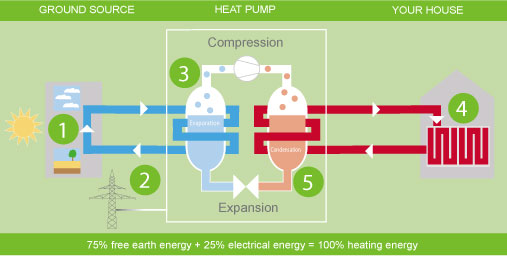
(1) The sun heats the earth. The liquid-filled ground loop absorbs this heat from the earth. The warmed-up ground loop fluid enters the evaporator heat exchange coil (3). Here it releases the heat it picked up in the earth and transfers it to the refrigerant as it boils off the refrigerant (refrigerants are fluids that can evaporate at low temperature). Having given off its heat, the cooled-down loop fluid flows back out through the ground loop (2) where it starts to absorb heat again repeating this part of the cycle.
The refrigerant from the evaporator in the form of vapour enters the compressor where it is compressed. This compression raises the temperature of the refrigerant (same principle as pumping a bicycle tire raises the temperature of the air in the tire). The hot refrigerant is then transferred to the condensing heat exchanger coil (5). Here the hot refrigerant is used to heat the fluid in a radiant heating system (4), or to heat the air in a forced air heating system. After the hot refrigerant gives up its heat it passes through an expansion valve to get it back to the same pressure and temperature as it started from so that the cycle can repeat.

